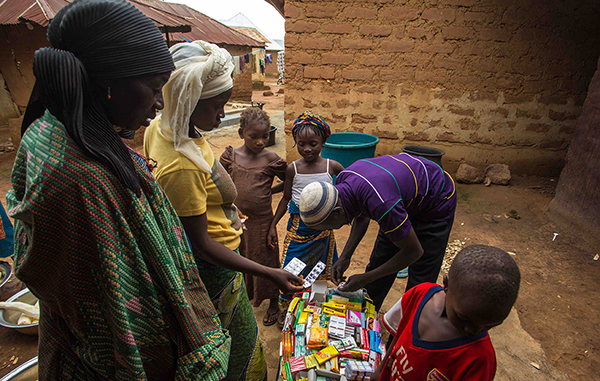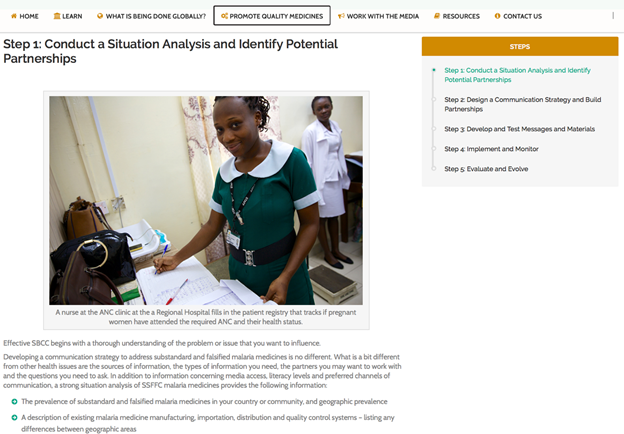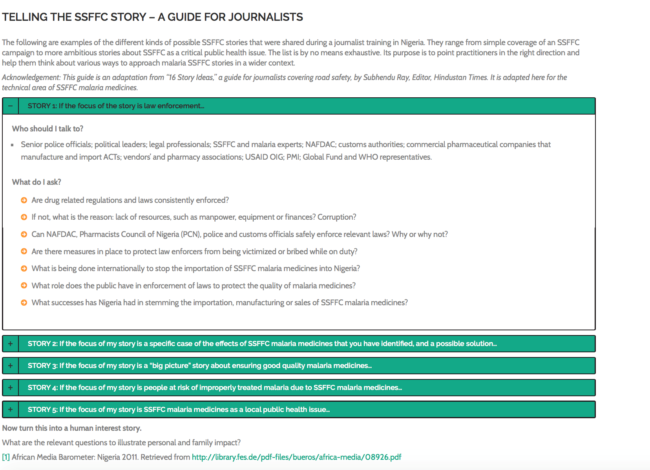HC3’s Newest I-Kit Focuses on Using SBCC to Promote Quality Malaria Medicines
A practical, evidence-based guide for program managers creating SBCC strategies to help combat poor quality malaria medicines
Malaria is a preventable and treatable disease, still affecting half of the world’s population.
Although the malaria community has made great strides, recent studies have found a widespread prevalence of poor quality malaria medicine, especially in sub-Saharan Africa and Southeast Asia. These medicines could severely threaten progress made because of their inability to treat malaria, as well as their role in contributing to artemisinin resistance. While many groups are working to reduce the global impact of poor quality medicines through activities aimed at improving larger systems (e.g., supply chain, regulation and law enforcement), these efforts alone cannot eliminate the problem entirely – nor can they protect today’s malaria medicine consumers from the dangers of these medicines.
 Fortunately, social and behavior change communication (SBCC) has a role to play in this fight, promoting the positive antimalarial vending, buying, use and reporting practices that help individuals and communities reduce their risk. However, these strategies must be carefully designed around the root of the medicine problem (e.g., manufacturer error, counterfeiting, poor storage conditions due to limited infrastructure or diversion), country needs and available resources to be effective.
Fortunately, social and behavior change communication (SBCC) has a role to play in this fight, promoting the positive antimalarial vending, buying, use and reporting practices that help individuals and communities reduce their risk. However, these strategies must be carefully designed around the root of the medicine problem (e.g., manufacturer error, counterfeiting, poor storage conditions due to limited infrastructure or diversion), country needs and available resources to be effective.
It can be difficult to determine which target audience(s) and behavior(s) to prioritize in SBCC campaigns but HC3 has developed a tool that walks program managers and decision-makers through the process and key considerations for developing an effective communication strategy to address local malaria medicine issues.
HC3 followed three steps to ensure the new I-Kit was evidence-based and practical. First, it conducted a desk review to learn what was known about poor quality medicines and what was being done to combat it. While this search revealed a limited number of evaluated, strategically designed SBCC activities, it did identify several partners working on this issue – although not necessarily partners with training in SBCC. These groups included pharmaceutical companies, regulatory agencies, national malaria control programs, implementing partners, research teams, and medicine monitoring and surveillance organizations.
Next, HC3 held a two-day global stakeholder meeting in Accra, Ghana, with representatives from the organizations listed above. During this meeting, participants discussed work they have done related to this issue, identified gaps and overlap in their work and country situations, and shared the type of support they would want to help them develop and conduct an SBCC campaign to address poor quality malaria medicine. This meeting highlighted the importance of collaborating with the many partners influencing the local malaria medicine situation – and the need to form these partnerships earlier in the process.
Finally, HC3 collaborated with Nigeria’s National Malaria Elimination Program (NMEP), its National Agency for Food and Drug Administration and Control (NAFDAC) and nongovernmental stakeholders there to design and test the SBCC strategy aimed at protecting consumers and communities from poor quality malaria medicine. A country-specific landscaping exercise was conducted and a stakeholder meeting held to develop a communication strategy targeting consumers, informal medicine vendors and policymakers. Media specialists were also consulted on how to best report on poor quality malaria medicines.
The findings and lessons learned throughout this process are incorporated into the Promoting Quality Malaria Medicines through SBCC I-Kit, an online tool to support program managers interested in developing a tailored SBCC strategy to address the specific malaria medicine issue, as well as the local context, needs and resources.
The I-Kit includes background information about malaria medicine and activities being done to combat them, as well as resources and program examples.
 It breaks down each of the essential elements in developing and implementing a communication strategy – walking the user through everything from the situation analysis to message development and campaign evaluation.
It breaks down each of the essential elements in developing and implementing a communication strategy – walking the user through everything from the situation analysis to message development and campaign evaluation.
The I-Kit also includes key considerations to keep in mind when selecting audiences and messages – so messages highlight the presence of good quality medicines and empower consumers, as opposed to scaring them and making them feel powerless (this framing will make an audience more likely to act).
The I-Kit provides recommendations for the types of partners to include in this process. Practitioners are encouraged to use the I-Kit in partnership with other stakeholders.
Finally, the I-Kit includes guidance on how to expand program reach by working with the media, as well as story examples and lessons learned from the media engagement activities from the SBCC campaign in Akwa Ibom, Nigeria. This section includes sample stories, and tips for holding a news conference, writing a press release, providing an interview and hosting a media training about poor quality medicine.
The I-Kit is currently in beta form and HC3 invites you to send comments on its contents as well as your experiences with this topic and lessons learned while implementing similar programs or using the I-Kit. Send feedback using the “Contact Us/Feedback” page or using the discussion page on Springboard for Health Communication Professionals.
Additionally, review and submit related resources and program materials to the Health COMpass Trending Topics page on Promoting Quality Malaria Medications.










Leave a Reply
Want to join the discussion?Feel free to contribute!